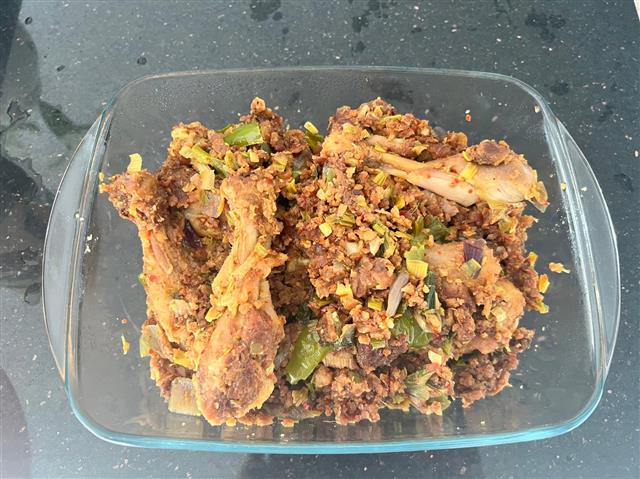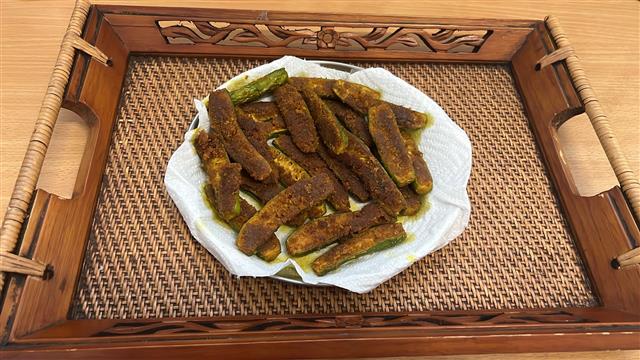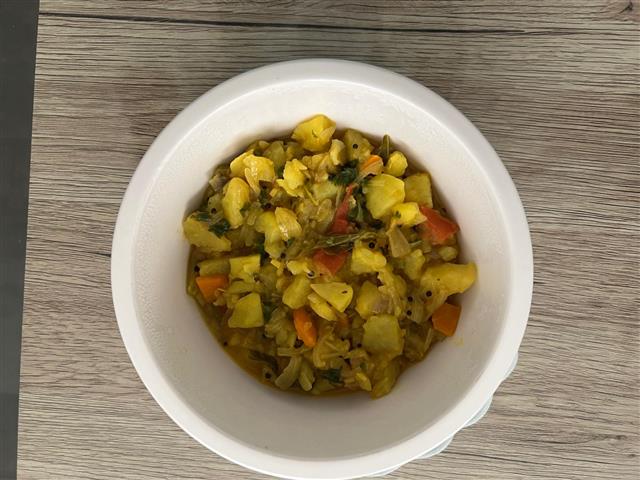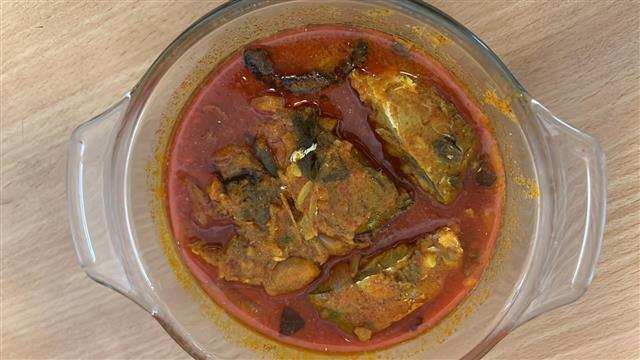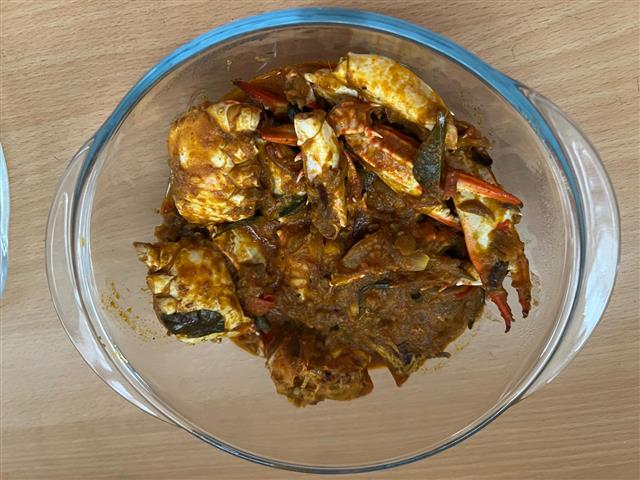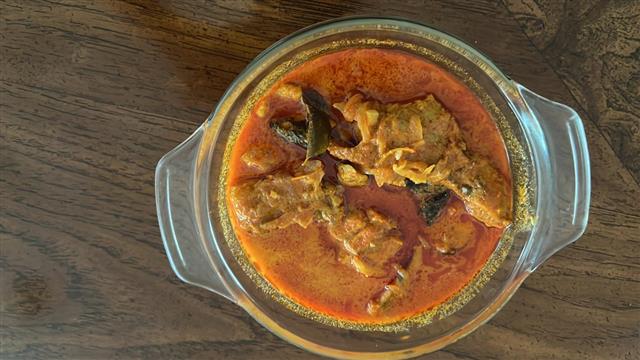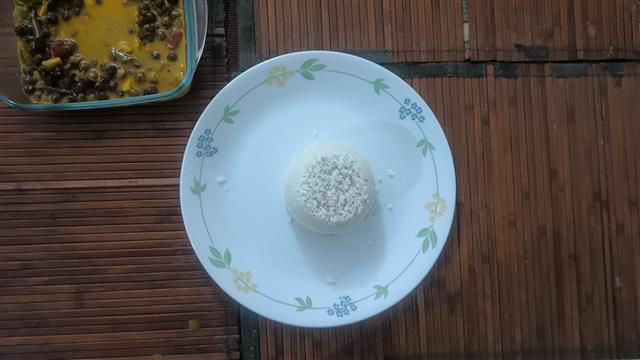
Mutton Stew
(4 reviews)
Mild, creamy, and fragrant, Kerala Mutton Stew is a comforting dish made with tender mutton, vegetables, and coconut milk.
Unlike fiery red curries, this stew is slow-cooked with gentle spices like cardamom, cloves, and cinnamon to let the natural sweetness of coconut shine.
Best served with appam or string hoppers that soak up the delicate, spiced coconut broth. Light on the tongue but rich in flavor, this is Kerala comfort food at its finest.
Ingredients
Directions
- How to prepare fresh coconut milk • First Milk: Grind coconut with 1½ cups of water, strain through a fine sieve and set aside. • Second Milk Add the coconut solids back into the mixer with another 1½ cups of water. Blend and strain again.
- Cut potatoes and carrots into small cubes. Set aside.
- In a pressure cooker, heat oil and add cinnamon, cloves, and cardamom. Let them release their aroma for 1–2 minutes
- Add sliced onions, ginger, green chillies, and garlic. Sauté until fragrant.
- Add mutton pieces and fennel seed powder. Stir well.
- Pour in the second (thin) coconut milk. Close the lid and pressure cook for 8–10 whistles.
- Allow the pressure to release naturally. Open the cooker and set aside the mutton.
- Add cubed potatoes and carrots with ½ cup of water. Pressure cook for 2 more whistles.
- Once the pressure releases, open and return the cooked mutton stew to the cooker.
- Simmer for 2 minutes. Then add the first (thick) coconut milk, chopped coriander leaves, and a pinch of black pepper.
- Simmer gently for another 2 minutes without boiling.
- Rest for 10 minutes and serve.
Cooking Tips
• Coconut Milk: Always add the thick (first) coconut milk at the end of cooking. Never boil it, or it may split.
• Onion Texture: Slice onions thin and sauté gently. They should not brown, to preserve the stew's light color.
• Vegetable Timing: Add potatoes and carrots after pressure cooking the meat. This prevents them from becoming mushy.
• Spices: Stick to whole spices like cinnamon, cloves, and cardamom. Avoid garam masala or heavy powders that can overpower the dish.
• Simmering: After adding the thick milk, keep the flame low and stir gently. This helps blend everything into a smooth stew.
How to Serve
→ Appam or Palappam: The classic pair. Its soft center and crispy edges are perfect for soaking up the stew.
→ Kallappam or Vellayappam: Spongy and slightly sweet, these are perfect for festive mornings.
→ Dosa: Freshly made soft dosas work well to mop up the last of the stew.
→ Idiyappam (String Hoppers): Light and fluffy, they absorb the stew wonderfully.
→ Matta Rice: For a more filling lunch version, serve it with Kerala red rice and a side of pickle or thoran.
The Story Behind Mutton Stew
If you've ever had a Sunday breakfast in a Kerala Christian home, you know the joy of waking up to the smell of stew simmering in the kitchen. The spices are subtle, the meat tender, and the coconut milk wraps around everything like a warm blanket. This dish is often made for special mornings — Easter, Christmas, or the visit of a relative.
I remember those breakfast mornings at my friend's place. The first batch of appams would already be resting in a warm towel. This stew holds memories of happy times with childhood friends and everyone asking for second helpings even before finishing the first.
Today, when I make it, I hold onto those rituals. I simmer slowly, add pepper at the end, and let the stew rest before serving. Because this isn't just a dish—it's a tradition passed down from ancestral kitchens.
What Is Mutton Stew?
Kerala Mutton Stew as we know it today is primarily a Syrian Christian dish, though it may share superficial similarities with Western-style stews (subtle spicing, use of meat and potatoes). The base — coconut milk, cardamom, ginger, and green chillies — is entirely Malayali in nature.
This Mutton Ishtu is a delicately spiced, coconut milk–based dish cooked with soft chunks of mutton and vegetables like potato and carrot. Unlike typical Indian curries, this dish doesn't rely on heavy spice powders or chili. The flavor comes from whole spices, slow-cooked onions, and the richness of fresh coconut milk.
The onions are sliced finely and sautéed until translucent, not browned. The spices, cardamom, cloves, cinnamon, and fennel are just enough to enhance the dish, not dominate. Then comes the mutton, cooked in second-pressed coconut milk until tender.
Vegetables like potato and carrot are added next, and finally, a pour of thick, first-extracted coconut milk finishes the dish, adding a rich creaminess. The stew is light in appearance but is deeply flavorful and comforting both as a festive and an everyday meal.
Regional Variations
In some parts of Kottayam and Alappuzha, variations of the stew include chopped tomatoes or even whole shallots.
In Kollam, you'll often find it garnished with fresh curry leaves and a splash of coconut oil before serving.
Homes in Thrissur sometimes add a small spoon of ground coconut paste for extra richness, especially when serving it with rice instead of appam.
In Thiruvalla and other places, onions are swapped with pearl onions or shallots for a sweeter, more rustic stew
With time, cooks outside the state and abroad have embraced this dish. You'll find adaptions with chicken, beef, vegetables, or even tofu, while preserving the basics spices, and of course, coconut milk.
This isn't a recipe meant to be rushed. It's a dish that asks for your time, and in return, gives you something timeless.
Pro Tips for Perfect Results
→ Use freshly pressed coconut milk whenever possible. Canned milk works, but fresh gives the stew its signature sweetness and aroma.
→ Add a dash of coconut oil just before serving for extra aroma and that final Kerala touch.
→ Always rest the stew for 10–15 minutes after switching off the stove. The flavors settle beautifully, and the gravy thickens slightly.
→ If your stew looks too watery, simmer uncovered for a few extra minutes before adding thick milk.
Mutton Stew Variations
Chicken Stew•: Swap mutton with chicken and reduce cooking time.
Vegetarian Stew•:Use earthy vegetables like yam, sweet potato, or raw banana, with chickpeas, peas, and cauliflower. Add cashews for richness.
Egg Stew: Boiled eggs simmered in the same coconut base, perfect for quick weeknight meals.
Spicier Version: Add crushed black pepper or a pinch of garam masala for a stronger kick.
With Coconut Paste: Some traditional recipes use ground coconut paste instead of milk for a coarser, nuttier stew.
With Tomatoes: A few chopped tomatoes sautéed with pearl onions or shallots give a slight tang and deepen the taste.
Vegetable Swap Tips If you want to make it with other vegetables:
• Green beans – Add chopped beans along with carrots for a crunchier texture.
• Cauliflower florets – Add toward the end of cooking to avoid over-softening.
• Green peas – Frozen peas can be stirred in with the vegetables for a hint of sweetness.
• Yam or Raw banana (plantain) – Used in older, rustic versions of the stew in some households.
• Sweet potato – A mild but creamy vegetable that pairs beautifully with the coconut base.
Diet-Friendly Adaptations
• Low-Fat Version: Use light coconut milk or reduce the quantity. Add more vegetables to stretch the stew without adding richness.
• Dairy-Free: Naturally dairy-free, just ensure your appam or bread is dairy-free too.
• Vegan Option: Omit mutton and use hearty vegetables like yam, sweet potato, and raw banana with the same spice base.
Storing & Reheating Tips
→ Fridge: Store in an airtight container for up to 2 days.
→ Reheat: Reheat gently over low heat. Do not boil after adding coconut milk—just warm it slowly.
→ Freezer: You can freeze the stew (without thick milk) and add fresh coconut milk while reheating for the best texture.
Common Mistakes to Avoid
→ Rushing pressure cooking: Make sure the mutton is cooked until tender before adding the vegetables. Undercooked meat ruins the texture of the final dish.
→ Overcooking Vegetables: Always pressure veggies for a shorter time to get that bite.
→ Boiling Coconut Milk: Boiling splits the milk and affects both texture and taste. Always simmer gently.
→ Using Powdered Spices Stick to whole spices. Powdered ones cloud the stew and change its flavor profile.
→ Using red chilli or turmeric powder: These change both color and flavor. Stick to green chillies and black pepper for authentic results.
→ Adding both the milk together: Use second milk for cooking and first milk only at the end. This layering keeps the stew creamy without becoming too thin.
Frequently Asked Questions
- Can I use canned coconut milk?
Yes, but try to find one without preservatives. Shake well and dilute slightly to replicate the first and second press consistency.
- Is this the same as ishtu?
Yes! Mutton stew is a type of ishtu, the Malayalam word for lightly spiced, coconut-based stews.
- Can I skip the pressure cooker?
Absolutely. Slow cook in a heavy-bottomed pan for 45 to 60 minutes until the meat is tender.
- What cut of mutton works best?
Bone-in cuts like shoulder or leg work best. The bones enrich the stew and keep the meat moist.
Equipment Needed
→ Pressure Cooker – For fast and even cooking of mutton
→ Mixer/Blender – To grind coconut for milk
→ Fine Sieve or Cheesecloth – For straining coconut milk
→ Spatula – To gently stir without breaking vegetables or curdling the coconut milk
→ Knife & Chopping Board – For prep work
→ Small Bowls – To soak spices or prep the milk if needed – For fast and even cooking of mutton
